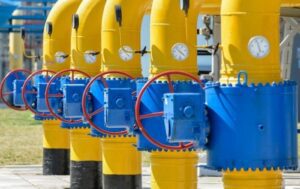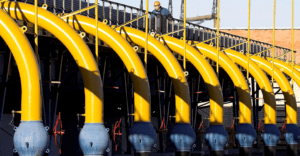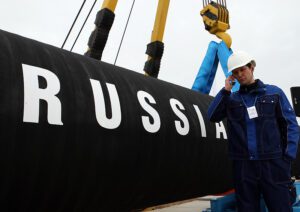
Ukraine plans to produce 18.5 billion cubic meters in 2022. meters of gas, which is 6.6% (1.3 billion cubic meters) less than in 2021, said Deputy Energy Minister Nikolai Kolesnik.
“Based on the volume of actual production that is today, the forecast volume for this year is approximately 18.5 billion cubic meters. This is without taking into account potential losses,” he said in Kyiv on Thursday.
Kolesnik specified that today the daily gas production in the country is 49.5 million cubic meters. m, while before the start of the war it was about 55 million cubic meters. m. At the same time, companies are not yet able to fully carry out new drilling and workover of wells, but only maintain the maintenance of the existing said fund. This is due to the use of equipment that from the air can look like a military one.
According to him, the gas consumption forecast for 2022 is about 21 billion cubic meters. The Deputy Minister clarified that this forecast is based on the consumption profile of previous years, while in the conditions of war and the resettlement of people it is difficult to say exactly what consumption will be.
As reported, natural gas production in Ukraine in 2021 amounted to 19.8 billion cubic meters. m, incl. private companies – 5 billion cubic meters. m.

German Vice-Chancellor, Minister for Economy and Climate Protection Robert Habeck called the situation with gas supplies in the country “serious” and called for a reduction in its consumption by 15-20%.
On the air of the ARD TV channel, referring to Gazprom’s announcement of a further reduction in fuel supplies from July 27, he said that “we must be prepared for this,” and “this is a serious situation.”
Habek noted that Germany will continue to receive gas from the Netherlands and Norway, “we will be able to continue to fill the storage, but how quickly and in what volumes,” it will be clear later. He added that “we will not have gas in abundance.”
The minister called for a 15-20% reduction in gas consumption to avoid that “certain production chains simply cease to exist in Germany or Europe.”
The official promised that in the event of a shortage of gas, industrial sectors would be the first to suffer, while measures would be taken to provide residential buildings and infrastructure such as hospitals.
In an interview with DPA, Habek said he sees no “technical reasons” for Gazprom’s cuts in supplies.
As previously reported by Gazprom, gas pumping through Nord Stream will be reduced to one-fifth of its capacity from Wednesday.

The application for the transit of Russian gas through the territory of Ukraine remains at the level of the previous days and months.
Europe has been without Nord Stream gas for the second day.
The energy deficit was aggravated by a two-fold drop in electricity production due to wind.
TRANSIT THROUGH UKRAINE
“Operator GTS Ukrainy” accepted from “Gazprom” an application for gas transit for Tuesday in the amount of 41.2 million cubic meters. m, evidenced by OGTSU data. The indicator on Monday was 41.1 million cubic meters. m. Powers are declared only at one of the two points of entry into the Ukrainian GTS – the Suzha gas measuring station. The application was not accepted for the corridor through the Sokhranovka GIS.
OGTSU announced a force majeure for the acceptance of gas for transit through the GIS station “Sochranovka”, referring to the fact that it cannot carry out operational and technological control over the compressor station “Novopskov”.
Kyiv offered to transfer transit volumes from “Sochranovka” to GIS “Suja”, but “Gazprom” stated that this was technologically impossible.
At the same time, Ukraine insists that payment should still be made on the basis of the estimated volume of transportation of the long-term contract of 109 million cubic meters. m per day according to the “download or pay” rule. “Naftogaz” claims that it is now not receiving payment for transit and is preparing to apply to arbitration.
EUROPEAN MARKET
At the beginning of the new week, the production of electricity due to wind in Europe fell to 7.6% of the energy balance in the EU, while the average indicator for the past week was 15%, according to data from the WindEurope association.
Europe continues to pump gas into underground storage facilities. At the moment, the reserves are about 62.08%, according to data from the Gas Infrastructure Europe association. The increase over the last day was 0.46 percentage points. The current level of reserves in the UGC of Europe lags behind the five-year average by 1.24 percentage points. Since this year, the EU has introduced strict regulation of the use of underground storage facilities. By the beginning of the selection season in 2022, the reserves should be at least 80% of the capacity of the UHP, and 90% thereafter.
European terminals for receiving LNG in July are operating at an average capacity of 63% of their capacity, which is equal to the June indicator. For now, the region remains a premium market for LNG, as prices in Asia are slightly lower than European hubs.
Spot prices for gas in Europe against the background of the Nord Stream repair shutdown are at the level of $1,690 per thousand cubic meters. In Asia, prices are noticeably lower – the August futures on the JKM Platts index (Japan Korea Marker – reflects the spot market value of cargo delivered to Japan, South Korea, China and Taiwan) is trading at $1,390.

Romanian Prime Minister Nicolae Chuque said that after the commissioning of the Greece-Bulgaria interconnector on Thursday, his country will be able to supply natural gas to Moldova and Ukraine, European Pravda reports with reference to the Romanian news portal Digi24.
“Essentially, this interconnector will connect the network passing through Anatolia and the Adriatic, as well as connect to the BRUA pipeline, thus ensuring gas supplies to Bulgaria and Romania,” Chuquet said at a press conference with Greek Prime Minister Kyriakos Mitsotakis.
“And, of course, we can provide gas supplies to our eastern partners – Ukraine and the Republic of Moldova and other countries according to the distribution scheme of this gas network,” the Romanian prime minister added.
COMMISSIONING, GAS, GREECE-BULGARIA, INTERCONNECTOR, MOLDOVA, ROMANIA, UKRAINE

The volume of gas supplies from Russia to Europe has now halved compared to last summer, and their further decline is not ruled out, European Commission energy member Kadri Simson said on Monday.
“Gas deliveries from Russia now make up half of the volumes that we received at the same time last year. They may continue to decline,” Simson said before the EU meeting at the level of ministers of energy, transport and telecommunications.
With regard to gas supplies, the EU is ready for any developments, she stressed.
Simson added that at the meeting on Monday, she will present to the ministers concrete steps that, in her opinion, would help the countries of the union to be better prepared for the reduction in gas supplies. One such step is coordinating a reduction in demand for gas.
On Saturday, Simson said that 12 EU states were completely or partially left without gas from Russia. She added that last week the EU reached an agreement to increase gas supplies with Israel and Egypt, deepened cooperation with Norway, and final direct negotiations with Azerbaijan.
Simson stressed, BNS reports, that joint gas purchases require unanimity and coordination between member states, and that the work of the European Commission creates the necessary conditions for this.
“The good news is that in May, a record was once again set for the flow of LNG to Europe – 12.8 billion cubic meters – this is the largest monthly volume in history,” she said.
At the end of May, it was reported that Poland, Bulgaria, Finland and the Netherlands, due to their refusal to accept the new settlement system, had lost the opportunity to receive Russian gas.

In January-May 2022, Ukraine produced 7.831 billion cubic meters of natural gas, which is 1.9% more than in the same period last year (7.687 billion cubic meters), according to the infographics of the Energy Suppliers Association (ESA).
According to it, the average daily gas production in May increased by 1% compared to April, but is still below the pre-war production of this year. In particular, in January this figure was 55.4 million cubic meters per day, in February – 54.5 million cubic meters, in March – 49.9 million cubic meters, in April – 49.6 million cubic meters, and in May – 50.1 million cubic meters.
At the same time, according to the association, in May a number of private companies managed to bring gas production to a double level.
According to the association, amid Russian military aggression, gas consumption in the country continues to decline, which amounted to 11.726 billion cubic meters in the first five months of this year. In particular, in January 2022 it amounted to 3.972 billion cubic meters (less by 4% compared to January 2021), February – 2.822 billion cubic meters (less by 34%), March – 2.735 billion cubic meters (less by 24%), April – 1.483 billion cubic meters (less by 33%), and May – 0.714 billion cubic meters (less by 46%).
Earlier, the Cabinet of Ministers instructed NJSC Naftogaz Ukrainy to increase gas reserves in underground storage facilities (UGS) to 19 billion cubic meters at the beginning of the heating season 2022-2023, while 10 billion cubic meters on June 1, 2022.
While maintaining consumption of about 25 million cubic meters per day and production of about 50 million cubic meters per day during June-September, Ukraine will be able to replenish stocks in storage facilities during this period by 3 billion cubic meters, while up to 6 billion cubic meters of gas will be needed to import. Some of these volumes can be brought into UGS facilities for their storage by foreign companies.
At the same time, the head of the Energy Committee of the Verkhovna Rada, Andriy Gerus, specified in early June that plans for 19 billion cubic meters in storage could be adjusted depending on a number of factors.
ESA, GAS, PRODUCTION